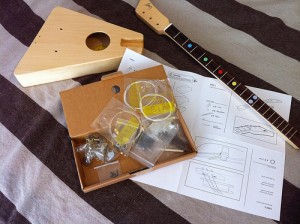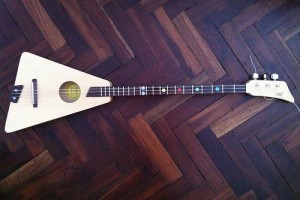The Loog Goes International
We told you this week about blog Ted El Mecánico, where Nacho wrote up a great review of the Loog Guitar. The original piece is of course in Spanish but he was very thorough, even posting sound clips and pictures to illustrate the Loog building process. We thought it would be a shame for all of you to miss it, so we managed to get it translated and decided to post it on the blog. Here goes!
I’ve wanted to try a Loog Guitar ever since I first saw that the project was successfully funded via Kickstarter. The guitars, designed by Rafael Atijas, were designed for both kids and adults to easily learn how to play in less time. A few weeks ago I managed to get my hands on one to experiment with and go through the entire assembling process. Here’s my experience.
The product
The guitar comes in a very neat and cute cardboard box that makes you want to rip it open and instantly build it. The box has a handle so you can later use it as a guitar cover to easily move it around. The unassembled parts come with a manual with instructions on how to build it, as well as a booklet with basic instructions on how to learn to play the guitar.
Building it
After opening the box comes the most “difficult” part, which is building it. It only takes 10 minutes to build the guitar. It’s very simple. The instructions can scare you at first. They’re very much like those that come with furniture, where you always have an extra screw at the end or are missing something and everything seems fragile; the only difference is that the Loog doesn’t have any of these problems. The manual is detailed, the pieces fit perfectly and you can tell the materials are of good quality. After building it you can tell that the instrument is done and sturdy, as if it had just left the factory.
The sound
You obviously can’t expect to have impeccable sound, but it actually sounds pretty good and at a good volume. It uses the same strings you’d use for any classical guitar, so you can choose whatever strings you want, of whatever quality you want [the Loog does come with a set]. Here’s a tiny clip where I recorded how it sounds right after building it:
After playing it for some days, all I have to say about the design is that bridge might be too high, even though the guys over at Loog told me it’s a known issue that can be easily solved. Lastly, a minor detail: the V-shaped model I got might be the coolest (for me), but perhaps not the most comfortable to play without a strap.
Thanks Nacho! That was a great review and we really appreciate the work you put into it. For more pictures of the Loog that Nacho took, visit Ted El Mecánico on Flickr. See you next week!



